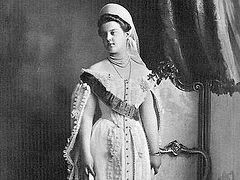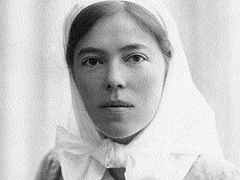 Grand Duchess Alexandra Petrovna Romanova. Artist: Timofei Andreyevich Neff Grand Duchess Alexandra Petrovna Romanova (Nun Anastasia) was born on May 21, 1838 in St. Petersburg into the family of Duke Peter Georgievich of Oldenburg and Duchess Therese of Nassau. Alexandra Petrovna’s grandfather came from the German family of the Dukes of Oldenburg. He came to Russia under Emperor Paul I (1796–1801), showed his good qualities in the service of the Russian Tsar, and later married one of the Emperor’s daughters—Grand Duchess Catherine Pavlovna (1788–1819). One of the sons of this couple was Peter of Oldenburg, Alexandra’s father, a Russian general, a well-known philanthropist, and a trustee of the Kiev care home for the poor. In Protestant Baptism the Duke of Oldenburg’s eldest daughter was named Alexandra Frederica Wilhelmina.
Grand Duchess Alexandra Petrovna Romanova. Artist: Timofei Andreyevich Neff Grand Duchess Alexandra Petrovna Romanova (Nun Anastasia) was born on May 21, 1838 in St. Petersburg into the family of Duke Peter Georgievich of Oldenburg and Duchess Therese of Nassau. Alexandra Petrovna’s grandfather came from the German family of the Dukes of Oldenburg. He came to Russia under Emperor Paul I (1796–1801), showed his good qualities in the service of the Russian Tsar, and later married one of the Emperor’s daughters—Grand Duchess Catherine Pavlovna (1788–1819). One of the sons of this couple was Peter of Oldenburg, Alexandra’s father, a Russian general, a well-known philanthropist, and a trustee of the Kiev care home for the poor. In Protestant Baptism the Duke of Oldenburg’s eldest daughter was named Alexandra Frederica Wilhelmina.
Modest, kind, and charming, Duchess Alexandra was very keen on literature, music, drawing, and charity work.
“Since childhood, I have been close to the sick and loved them, seeing the example of my parents, witnessing how my ever-memorable mother founded the first community of nurses in Russia,” the Duchess later recalled.
From 1854, Alexandra of Oldenburg was a full and honorary member of the Imperial Women’s Patriotic Society, as well as a trustee of the first Private School of Vasilyevsky Island.
The Duchess met her future husband, Grand Duke Nicholas Nikolaevich, in her youth, as the Oldenburgs were close to the Imperial Family. Alexandra was first invited to a royal dinner in 1853, when she was fifteen. It was then that she first saw her distant relative and future husband Nicholas.
On January 25, 1856, at the age of seventeen, Alexandra, who was born into a Lutheran family, embraced Orthodoxy with the name Alexandra. Having lived in Russia since childhood, Alexandra took this step easily. Nevertheless, during the sacrament, she was very worried and, according to the lady-in-waiting Anna Tyutcheva (1829–1889), “she was so worried that it even affected the color of her face, which was unnaturally pale.” On the same day, she married Grand Duke Nicholas Nikolaevich Senior, Emperor Alexander II’s brother. The Grand Duke devoted his life to a military career and was promoted from Captain to Field Marshal General of the Russian Army. His marriage was clearly dynastic in nature. Anna Tyutcheva wrote:
“The Sovereign and the Tsarina are delighted with this wedding... Duchess Alexandra, a gentle and sweet creature, should have a good influence on the Prince. Hopefully, in such an honorable position as a husband, the Grand Duke must come to his senses. It is absolutely necessary for him, since he has spent his life in the society of his mother’s ladies-in-waiting with hardly any intellectual interests.”
After the wedding, while a palace was being built for them, the newlyweds lived on the ground floor of the spare half of the Winter Palace, spending the summers at their Znamenka country estate near Peterhof, where Alexandra Petrovna began to engage actively in charity work right after her wedding. Here she opened a medical room where local peasants could seek medical aid. The Grand Duchess herself received patients, did bandaging, gave out medicine for free and did the dirtiest work. She loved supporting people in difficult situations, and helping the suffering became the main cause of her life.
In 1858, Alexandra Petrovna organized the Holy Protection Community of Nurses in the Galernaya Harbor of Vasilyevsky Island, the poorest part of St. Petersburg, where she opened a hospital, an outpatient clinic, a department for orphaned young girls and a medical school under the direction of Professor Sergei Botkin (1832–1889). She personally worked at her hospital. During the Russo-Turkish War, the Grand Duchess organized a medical detachment at her own expense. For a long time, Alexandra Petrovna participated in the Board of Orphanages of the Offices of Institutions of Empress Maria Feodorovna run by her father. She spent at least 20,000 rubles annually on charity—an enormous sum at that time. With the proceeds from her capital, she subsequently maintained twenty-three orphanages for 5,000 orphans.
Five years later, in 1861, Grand Duke Nicholas and his wife Alexandra solemnly moved to their new residence—Nicholas Palace on the Transfiguration Square in St. Petersburg, where she began receiving strangers.
Unlike other Grand Duchesses of the Romanov family, Nicholas Nikolaevich’s wife was absolutely indifferent to social life, rarely attended balls and never danced at them. She did not like luxurious outfits, dressed very modestly and seldom wore jewelry. The courtiers labelled her as “blessed” because of her commitment to religion. Prince D.A. Obolensky wrote:
“If the Grand Duke himself has not earned favors from God, then his wife—Grand Duchess Alexandra Petrovna—is undoubtedly in good standing with Him...”
For many years of her marriage, Alexandra was very happy and in her letters called her husband “my darling.” However, over time, there was a mutual cooling: instead of messages full of tender love, her letters turned into pieces of spiritual instruction, which irritated Nicholas Nikolaevich. His wife unsuccessfully tried to bring her husband to reason, but the Grand Duke continued, as before his marriage, to lead a life of debauchery, and he was no longer satisfied with his meek and pious spouse. After ten years of family life, their marriage broke up…
Nicholas Nikolaevich’s passion was ballet and ballerinas. In 1865, he became passionate about the ballerina Catherine Chislova (1846–1889), with whom he had an affair.1 In fact, he had a second family with her. The Grand Duke’s personal life served as a source of much gossip in St. Petersburg society. By that time, Nicholas Nikolaevich and Alexandra Petrovna already had two sons: Grand Dukes Nicholas (1856–1929) and Peter (1864–1931).
The Prince did not hide his mistress and settled her in a building opposite the palace. In 1879, to justify his unseemly act, Nicholas Nikolaevich invented an insidious scheme to get rid of his legitimate wife: He publicly accused Alexandra Petrovna of having an affair with her father-confessor, Archpriest Vasily Lebedev, rector of the house church of the Grand Ducal Palace in honor of the “Joy of All Who Sorrow” Icon. At the insistence of Chislova, he ordered the Duchess to return all the jewelry given to her throughout their marriage. The Grand Duke was cruel to his wife, slandering her and expelling her from the palace. The Romanovs did not stand up for their relative; they had always found it strange that the Grand Duchess avoided social life, devoting too much time to charity.
When the scandal with Alexandra Petrovna’s expulsion from the palace broke out, Emperor Alexander II sided with his brother, since he himself had never been an exemplary husband. The Emperor even refused to receive the Grand Duchess, listen to her complaints and explanations, instead ordering her to be exiled from Russia under the pretext of long-term treatment, which, indeed, she needed. The fact is that shortly before the scandal, during a carriage ride, the horses bolted, the carriage overturned, and Alexandra Petrovna fell, injuring her spine. As a result, the Duchess was paralyzed, unable to move, and became bedridden. Much slandered and humiliated, she went abroad in 1879. While in exile, Alexandra Petrovna dreamed of returning to her motherland. A year and a half later, Alexander II was assassinated and Alexander III ascended the throne. Unlike Alexander II, the new Emperor condemned Nicholas Nikolaevich’s vile act against his wife and allowed her to return to Russia.
In the summer of 1881, on the way to her motherland, in a wheelchair and accompanied by her sons, Alexandra Petrovna wished to see Mt. Athos. The yacht moored at the pier of the Russian St. Panteleimon’s Monastery. Since women are not allowed to set foot on the Holy Mountain, she communicated with Russian monks and members of the governing body of Mt. Athos on board the yacht. The monks brought the Apostle Andrew’s foot to the Grand Duchess’s deck to venerate, and at the request of the brethren, she handed them the foundation stone for the new cathedral church at the Russian monastery. The chronicle preserved the details of her visit to the shores of Mt. Athos and the impressions of the monks from the stay of the God-loving pilgrim:
“Truly, we had great spiritual consolation from Her Highness’ visit. It is gratifying for the soul to see a pious mood in every person, and it is incomparably more gratifying to see it in someone who holds such a high position in society—a member of the Russian Royal Family which is so dear to all of us!”
Having taken up her residence in Kiev, in 1889 Alexandra Petrovna was carried away by the idea of “living monasticism”, which involved combining monastic labors with active service to others, charity, and free medical care for the sick in need.
“No monastic vows or rules prevent you from loving your neighbor as yourself, serving the sick, and feeding the indigent,” she wrote in those years.
To achieve her ambition, the Duchess acquired land for the construction of a future convent. Only later did she learn that seventy years before its foundation, Blessed Theophilus (Feofil; 1788–1853)—a “Fool-for-Christ”, a hieroschemamonk, an ascetic, and a visionary—prayed at this place and foretold that it was holy, that there would be a convent there, and a royal lady would be its head. His prophecy came true.
A year after the start of construction, the buildings of the large Holy Protection Convent had grown. The convent complex comprised living quarters, which were joined to the Church of the Protection of the Mother of God, and twelve other buildings. A hospital for the poor was opened at the convent with the only X-ray room in Kiev. A school was set up, along with an orphanage for girls, a home for terminally ill women and another one for the blind. Later, a free outpatient clinic was established, which received up to 500 patients a day, together with a pharmacy with free medicine, needlework workshops, a hotel for pilgrims and visitors, a prosphora bakery with a bread bakery, a kitchen, a laundry, a greenhouse, a bee garden, and outside—a farm yard and a stable.
The community founded by the Duchess was not only a convent, but also a medical institution for the poor, in which the junior medical staff consisted of nuns and novice nuns of the convent. In a private letter, Alexandra Petrovna wrote:
“I donated everything I had acquired and all my possession and real estate to the convent, which was called the Kiev Cenobitic Convent.”
Despite the strictness of the Studite Rule introduced at the convent, the number of those who desired to enter in the first year was 400—more than twice as many as the convent could admit. Locals brought and left blind and crippled people at the hospital gate. So there was a whole ward for the disabled at the convent. Blind people were taught church singing. Orphans and the infirm—all were cared for, fed and looked after. In 1897, Alexandra Petrovna prevented a typhus epidemic in Kiev by organizing several specialized hospitals.
In 1888, a miracle occurred at the convent: One day, after praying in front of the Pochaev Icon of the Mother of God, the Duchess got up and from that moment on was able to move independently. In a letter to Metropolitan Platon of Kiev, she wrote about her healing:
“I dared to pray to my Intercessor: ‘If it pleases Thee, O Mother of God, Queen of Heaven and earth, restore me to serve Thee, accept my sinful labors and zeal. Let me serve Thee and the holy convent set up in Thy name for the rest of my life.’ I sighed prayerfully once more to the Most Pure and Most Blessed Mother of our Lord and uttered, ‘Help me!’ Next I got up and took a few steps...”
 Novice Nun Anastasia Now she could stand at the operating table for hours, assisting surgeons during operations, caring for patients, and watching at their bedside for a long time. One of the convent nuns wrote in her diary:
Novice Nun Anastasia Now she could stand at the operating table for hours, assisting surgeons during operations, caring for patients, and watching at their bedside for a long time. One of the convent nuns wrote in her diary:
“Mother Alexandra used to say, ‘When approaching a suffering patient, imagine that you are approaching Christ Himself and serving Him!’ The main and permanent testament that we heard from the Grand Duchess was about prayer: ‘Every step should be with prayer in mind… It is a mighty power that swallows up all evil. In this mood, you will always be peaceful and happy. Commend yourself to the will of God. Accept everything with fervent love from the hand of the Lord—then your soul will be filled with everlasting joy.’”
She would come to the hospital at six in the morning and leave at midnight. She did not disdain to wash the dirtiest patients in the bathroom with her own hands. “Novice Alexandra”, as the saint called herself, lived very modestly in a humble cell, struggling in fasting and prayer. All the patients who were admitted to the hospital were included in the Grand Duchess’ prayer list, and she prayed for them. For illiterate patients she wrote letters to their relatives herself. She supervised the nutrition of the patients, the cleanliness of the premises, and accompanied the patients to checkups.
After her husband’s death in 1891, Alexandra Petrovna took the veil secretly with the name Anastasia, which became known from her spiritual testament only after her repose. She could not do it earlier, since their marriage had not been officially dissolved. She was tonsured by an Athonite hieromonk who was passing through Kiev.
In 1896, the holy Emperor Nicholas II and his wife Alexandra Feodorovna visited “Aunt Sasha”, as the Romanovs called her. The Emperor donated a large sum for the expansion of the hospital and ordered 80,000 rubles to be allocated from the Treasury annually for the convent maintenance. In the presence of the royal couple, the foundation stone of the magnificent Cathedral Church of St. Nicholas the Wonderworker was laid. It was designed by Grand Duke Peter, Alexandra Petrovna’s younger son.
 Icon of St. Anastasia of Kiev. Photo: Mitropolia.spb.ru In 1894, the Grand Duchess’ health began to deteriorate, and she moved to live in the hospital, occupying only one ward in it next to the hospital church. Its window overlooked the church. When she could no longer get up, this window was opened for her during services.
Icon of St. Anastasia of Kiev. Photo: Mitropolia.spb.ru In 1894, the Grand Duchess’ health began to deteriorate, and she moved to live in the hospital, occupying only one ward in it next to the hospital church. Its window overlooked the church. When she could no longer get up, this window was opened for her during services.
St. Anastasia reposed in the Lord after severe suffering (she had stomach cancer) on April 13, 1900 in her cell in Kiev, having outlived her husband by nine years. In accordance with her will, she was buried in a humble pine coffin in front of the altar of the Holy Protection Church. A simple cross with the inscription “Sister Anastasia” was put up over her grave.
The ascetic was canonized by the Holy Synod of the Ukrainian Orthodox Church of the Moscow Patriarchate as “venerable” for local veneration in the Diocese of Kiev on November 24, 2009. On November 2, 2009 in Kiev her relics were uncovered and now rest at St. Nicholas Cathedral of the convent.
Today at St. Nicholas Cathedral the bishops, clergy and flock of Kiev pray to St. Anastasia for peace in the country and the cessation of internecine warfare.
literature
-
Krasheninnikova N.N., Anastasia of Kiev, The Orthodox Encyclopedia, Vol. 11. (Moscow, 2001), 256.
-
Tyutcheva A.F., At the Court of Two Emperors. Reminiscences. Diary. Editor I.V. Zakharov (Moscow: Zakharov, 2002).
-
Ageyeva L., Grand Duchess Alexandra Petrovna—St. Anastasia of Kiev (St. Petersburg: Severnaya Zvezda Publ., 2014).
-
Joseph (Shaposhnikov), Igumen, The History of the Holy Protection Cenobitic Convent in Kiev: Thesis (The Moscow Theological Academy. Sergiyev Posad, 1984).




